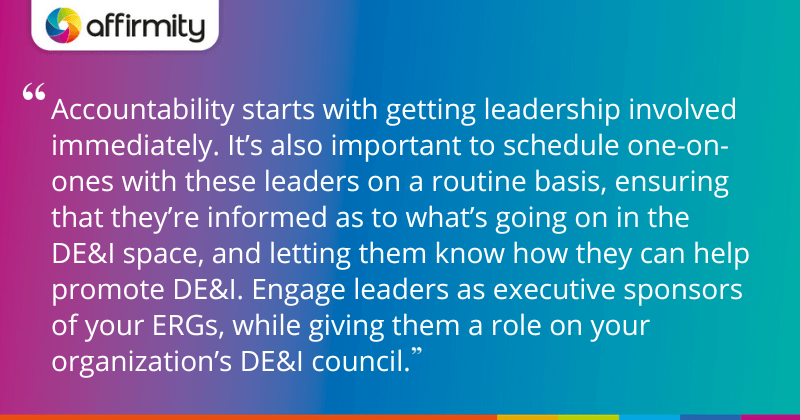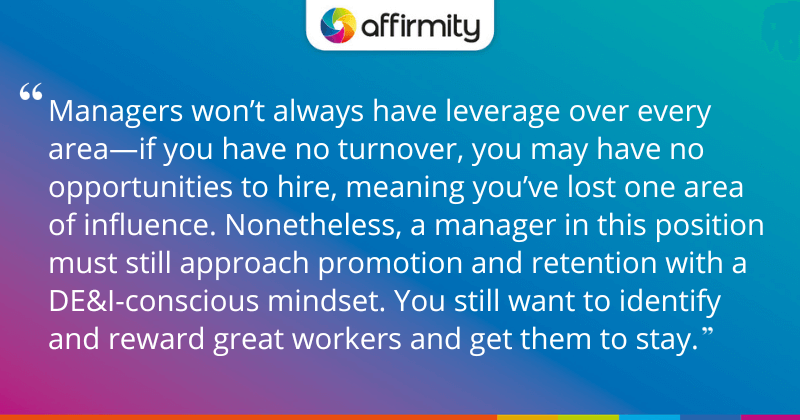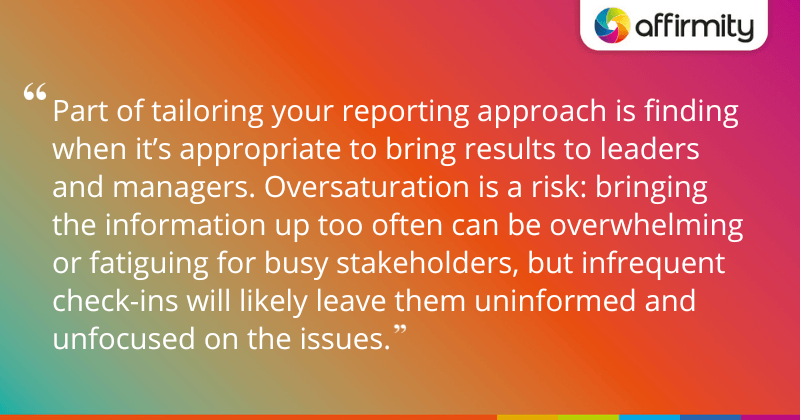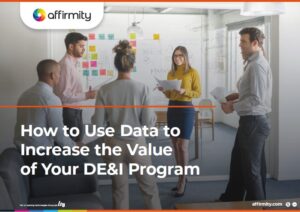A data-driven approach to your DE&I strategy is a necessity, but it won’t be a reality until you’ve established leadership buy-in. In this blog post, we take a look at how data can help establish accountability. With input from our own Senior Solutions Consultant, Roy Zambonino, Affirmity’s DE&I Consultant and Product Manager, Joe Valenzuela, and VP of DE&I at Western Governors University, Jason Thompson, we’ll also consider some tools and best practices that will help you manage your efforts.
How Can Organizations Hold Leaders Accountable for Achieving DE&I Objectives?
Accountability brings DE&I strategy into common organizational practice. Your goals should already be compatible with the overarching goals of your organization—accountability ensures that they’re factored into every decision going forward.
Accountability starts with getting leadership involved immediately. It’s also important to schedule one-on-ones with these leaders on a routine basis, ensuring that they’re informed as to what’s going on in the DE&I space, and letting them know how they can help promote DE&I. You’ll also want to engage leaders as executive sponsors of your ERGs, while giving them a role on your organization’s DE&I council.
Affirmity DE&I Consultant and Product Manager Joe Valenzuela explains one of the most effective ways he has involved leadership in the past: “In terms of executive sponsorships, I’ve had them communicate the DE&I story within ‘town hall’ or ‘fire-side chat’ events. They can be the ones moderating these sessions while also leveraging their authority in the organization to communicate what we’re doing within the company.”
MORE ON ACCOUNTABILITY AND DE&I | ‘Why Workplace Diversity Continues to Stagnate Without Accountability and Measurement’

The Importance of Leveraging Existing Obligations and Models
Valenzuela also identifies the organization’s ESG story as an important point of leverage (and one to which leadership is already accountable): “Obviously, if you’re a public company, the board and the CEO want to make sure that you’re able to help the company increase its ESG index score. And this is another way you can have them engage in the process.”
Though it can seem somewhat intimidating to have these conversations, leadership is often more receptive than expected. Jason Thompson, VP of DE&I at Western Governors University, consultant, is a long-time Affirmity user and collaborator. In his experience, leaders are typically invested but looking for direction. “The question they ask me is ‘What do you want me to do?’ They know diversity is important, but they need guidance on how to deliver it. One of the things I help them understand is that we ultimately want organizational change. And there are different organizational change models they know. Among them is ADKAR, and speaking about the process in those terms helps them approach the task in a familiar way.”
ADKAR—standing for Awareness, Desire, Knowledge, Ability, and Reinforcement—relies on making the organization aware of what you’re trying to do, gauging reactions, transferring knowledge, trialing the change, and repeating the process. Thompson continues: “Leaders are important in advocating for the message, but they need to know what’s expected of them and how it aligns with existing organizational goals. But like any other piece of organizational change, it takes commitment.”
What Tools or Practices Are Needed to Manage DE&I Efforts?
As Jason shares in his book, Diversity and Inclusion Matters: Tactics and Tools to Inspire Equity and Game-Changing Performance, DE&I leaders have responsibilities in three key areas:
- Who gets hired
- Who gets promoted
- How long someone stays
If every manager is making data-driven decisions within those three areas, they’ll achieve outcomes that improve the diversity of their organization. Managers won’t always have leverage over all three areas—if you have no turnover, you may have no opportunities to hire, meaning you’ve lost one area of influence. Nonetheless, a manager in this position must still approach promotion and retention with a DE&I-conscious mindset. You still want to identify and reward great workers and get them to stay.
MORE FROM THE BLOG | ‘A 5-Point Plan for Designing a Culture That Embraces Pay Equity’

Surface the Metrics Relevant to Individual Leaders
Equipping managers with a way of easily seeing metrics around these three areas should be a priority. Jason Thompson works with Affirmity to build a resource that does just that: “I use what I call a ‘leader guide’ or ‘equity table’. This could take you six months to build in-house when there are companies like Affirmity that can do this for you quickly. So I really do recommend maximizing your resources, and going with a consultant if you can. Then you can sit down with your leaders, show you understand the reasons why, for example, hiring diversity hasn’t increased, while challenging them in other areas such as promotions or high turnover.”
This should be part of a wider trend of making information easily accessible to leaders and managers. All reporting should be made specific to a leader and their purview—the people and the processes they’re in charge of and accountable for. They should be able to easily see where their part of the business is today, and what it could look like in the future.
Roy Zambonino, Senior Solutions Consultant at Affirmity, notes: “I think the important piece that a lot of times I see missing in these programs is concrete information that you can share with these leaders that makes it really, really simple for them. They need to see it at their particular level, not something that’s been translated from some other level that may or may not make sense to them. I think that’s where you start losing people.”
Joe Valenzuela adds: “The majority of leaders want to see you succeed as that means they succeed as well. And while it’s important to show them where the shortfalls are, we also want to show them the areas in which we’re doing well. If you tell that story, it gains traction, it gets people to stay and attracts potential talent to the organization, especially when combined with a robust internal and external communication strategy.”
LEARN ABOUT TAILORED REPORTING FOR YOUR AAP DATA | ‘How Affirmity’s TotalView Methodology Can Help You Maximize Management Visibility of AAPs’

Establish an Appropriate Cadence for Tailored Reporting
Part of tailoring your reporting approach is finding when it’s appropriate to bring results to leaders and managers. Oversaturation is a risk: bringing the information up too often can be overwhelming or fatiguing for busy stakeholders, but infrequent check-ins will likely leave them uninformed and unfocused on the issues.
Larger organizations will probably need to meet more regularly than smaller organizations. Jason Thompson proposes a monthly cadence for organizations of 10,000 employees or more, adding “I would think even most companies should have a quarterly sit-down to see where they’re at.” But he also stresses that it’s a predictive exercise. “If you organize your data in such a way, it allows you to continuously reflect on your trajectory. We could see that, at our hiring rate, we’re not going to maintain our current level of diversity. I need to know that in February, not at the end of the fiscal year.”
Joe Valenzuela encourages combining this with a layered approach for different individuals. “In the past, I’ve typically reported to the CHRO and we would have weekly meetings, covering DE&I as well as other areas. This is in contrast to my meetings with the CEO, which were more typically on a monthly basis. And then, when I worked with a publicly traded company, we met on a quarterly basis just ahead of their call with Wall Street—ensuring that they had up-to-date information on points of particular relevance to their investor audience.”
Continue Improving Your DE&I Program With Data-Driven Strategies: Download Our Guide
This article contains information originally included in our guide “How to Use Data to Increase the Value of Your DE&I Program”. Read the full guide to discover an even greater range of practical, real-world examples and data-driven techniques from Roy Zambonino, Joe Valenzuela, and Jason Thompson. These insights include:
- Why you should develop a data-driven DE&I strategy
- Why it’s important to set realistic goals and targets
- How organizations can use data to establish those goals and targets
- And more!

Download the full guide today.
About the Author
Jeffery D. Lewis is co-managing director for Affirmity. He oversees professional services and sales for Affirmity’s affirmative action consulting services and diversity planning programs. He leads teams of consultants who deliver services spanning affirmative action, EEO compliance, and diversity planning. He also oversees a team of experts who specialize in evaluating allegations of discriminatory employment practices.
With more than 35 years with the company, Mr. Lewis has assisted hundreds of clients across numerous industries. He regularly presents executive seminars on all aspects of affirmative action and diversity management.
